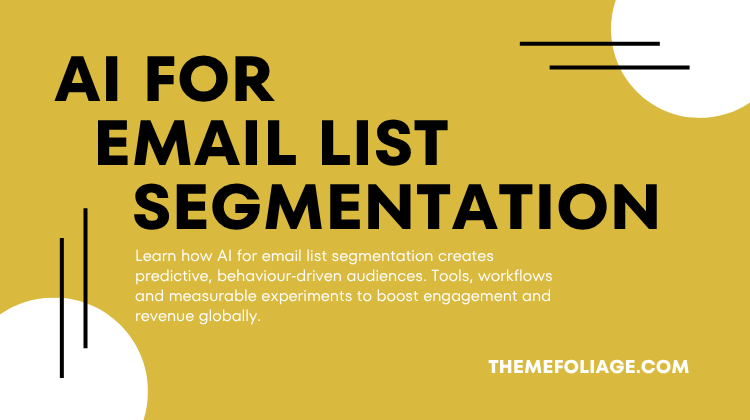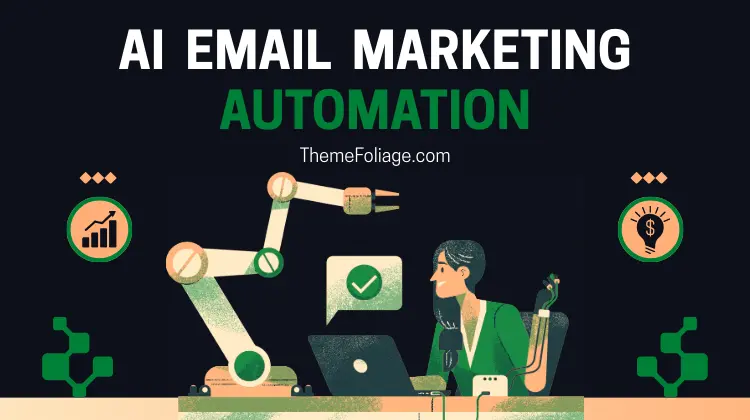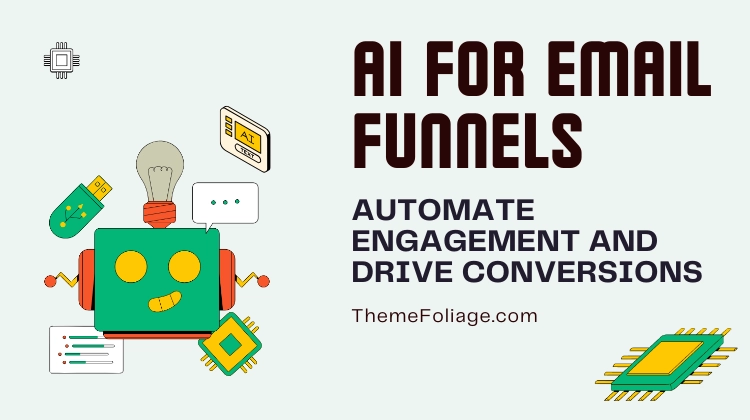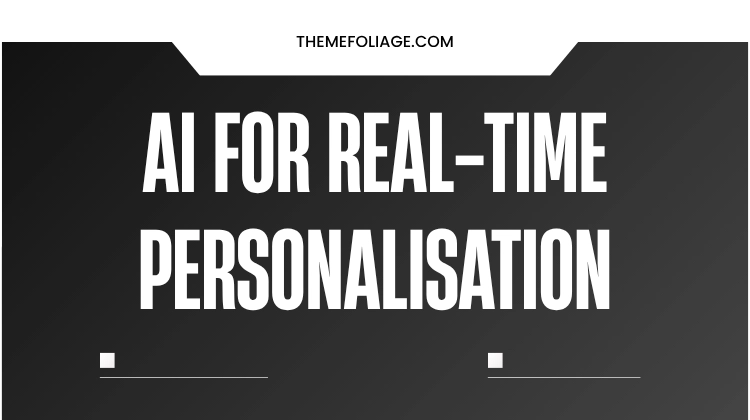Segmenting your email list used to mean a few static groups: new subscribers, buyers and inactive users. In 2025, AI turns segmentation into a live, predictive system that groups people by intent, value and micro‑behaviour automatically and continuously.
AI segmentation increases relevance, improves deliverability and lifts revenue per message by ensuring each email lands in the right inbox with the right content at the right time.
This guide explains the why, the how, the tools (prices may change), a step‑by‑step implementation plan and measurement framework so you can build international, privacy‑respecting segmentation that grows engagement and revenue.
Why AI Segmentation Outperforms Manual Segments
- Dynamic membership: AI updates segments in real time as subscribers behave, avoiding stale static lists.
- Predictive value: Models predict CLV, churn risk and conversion propensity, so you prioritise high‑impact audiences.
- Micro‑personalisation at scale: Thousands of micro‑segments become actionable without manual maintenance.
- Improved deliverability: Sending relevant content reduces complaints and unsubscribes, improving inbox placement.
- Cross‑channel activation: Segments feed ads, in‑app messages and onsite personalisation for coherent experiences.
AI turns segmentation from a reporting exercise into an activation engine that feeds personalised journeys and monetisation rules.
Core AI Segmentation Types and Signals
- Behavioural segments: Recent opens, click patterns, browsing sequences, product views, video watches.
- Predictive segments: Likely-to-convert, high‑LTV, at‑risk/churn, next‑purchase window.
- Value segments: CLV tiers, repeat‑buyer clusters, high‑AOV customers.
- Lifecycle segments: New subscriber, nurtured lead, active customer, dormant user.
- Engagement micro‑cohorts: Time‑of‑day engagers, long‑readers, short‑scrollers.
- Intent clusters: Price shoppers, feature explorers, upgrade‑ready users (inferred from behaviour).
- Contextual segments: Device, location, timezone, language, referral source.
Signals come from email interactions plus first‑party data (site events, product telemetry) and privacy‑compliant enrichments.
Recommended Tools and Notes on Pricing
Prices change frequently; confirm current plans before buying.
| Tool | Primary capability |
|---|---|
| Klaviyo | Behavioural segmentation + predictive CLV for ecommerce |
| Ortto | Predictive segmentation and journey activation for SMBs |
| Segment (Twilio) | CDP for event ingestion and activation across channels |
| Braze | Real‑time segmentation and multi‑channel orchestration |
| Salesforce Marketing Cloud / Einstein | Enterprise predictive segmentation and scoring |
| Pecan AI / Hightouch | No‑code predictive models and audience syncs |
| Amplitude / Mixpanel | Behaviour analytics feeding segmentation features |
Pick a stack that centralises events (CDP or data warehouse) and supports two‑way sync to your ESP and ad platforms.
Step‑by‑Step Implementation Roadmap
- Start with a data audit
Map all available signals: email opens/clicks, site events, purchases, product usage, ad interactions, and enrichment attributes. Ensure consistent event naming and timestamps. - Define business objectives and KPIs
Choose 1–3 goals for segmentation: increase conversion rate, reduce churn, raise revenue per message, or improve deliverability. - Build a central event layer (CDP/warehouse)
Stream events server‑side when possible to avoid client drops. Resolve identities deterministically where feasible (email + login) and supplement with probabilistic stitching carefully. - Create initial rule‑based segments
Implement fast wins: recent purchasers, 30‑day inactive, cart abandoners. Use these to validate activation flows. - Train predictive models
Train models for CLV, churn risk and conversion propensity using historical labels and feature sets: recency, frequency, monetary, engagement velocity, product interest. - Surface AI segments and explainability
Produce named segments (High‑Value Likely‑Buyers, At‑Risk VIPs, Price Shoppers) and attach short explanation codes so marketers trust and understand them. - Activate segments across channels
Sync segments to ESP, ad platforms and onsite personalisation. Create tailored email journeys and channel suppression rules to avoid oversending. - Run incremental experiments
Use holdouts: treat part of each segment as control to measure real incremental lift from AI‑driven messaging. - Measure and iterate
Track segment performance vs control: conversion lift, revenue per message, unsubscribe/complaint rates, and model accuracy; retrain models on a schedule. - Roll out international variants
Localise segment definitions where necessary (behaviour norms and LTV differ by market) and respect regional consent and data residency.
Example Segments and Activation Ideas (actionable)
- High‑Value Likely‑Buyer
- Signals: high CLV score, recent site visits to product pages, multiple cart adds in 7 days.
- Activation: personalised product email with social proof + priority support CTA; seed lookalikes for paid channels.
- At‑Risk Subscriber (12–30 days inactivity)
- Signals: drop in open rate, no site activity, reduced app sessions.
- Activation: reactivation ladder (personalised value reminder → exclusive limited offer → survey), holdout to measure incremental reactivations.
- Feature Explorer (SaaS)
- Signals: used advanced feature multiple times but no upgrade.
- Activation: targeted case study email + tailored demo invite with calendar link.
- Price Shopper
- Signals: frequent price-checking behaviour, coupon page visits.
- Activation: personalised discount with urgency and product comparators; exclude from full‑price campaigns.
- Mobile Nighttime Engager
- Signals: opens/clicks primarily between 20:00–02:00 local time on mobile.
- Activation: schedule sends to match preferred window; use short, action‑oriented copy.
Testing, Measurement and Governance
- Always use holdouts: split segments into exposed and control groups to measure causal uplift.
- KPIs: conversion rate, revenue per message, unsubscribe and complaint rates, CLV uplift, deliverability metrics.
- Model monitoring: track AUC/precision, feature drift, and segment population changes.
- Consent and privacy: check consent state before adding users to segments and sync only permitted attributes.
- Explainability: log top signals that drove segment membership for audits and marketer trust.
Common Pitfalls and How to Avoid Them
- Over‑fragmentation: creating too many tiny segments that starve statistical power; group similar micro‑segments by business actionability.
- Ignoring deliverability: frequent sends to predictive segments can harm sender score, implement caps and suppression lists.
- Blind automation: auto‑send without human checks can propagate errors, use campaign approvals for high‑impact segments.
- Poor identity stitching: split identities lead to duplicated messaging, invest in deterministic IDs where possible.
- Model bias: ensure models don’t unfairly prioritise or exclude groups; audit outcome distributions across regions and demographics.
Real‑World Example (concise)
An international ecommerce brand built AI segments for “High‑Value Likely‑Buyers” and “Cart Abandoners with Intent.”
After syncing segments to Klaviyo and launching tailored two‑email flows with personalised product blocks, they measured a 27% lift in checkout conversion from the AI segment vs the previous rule‑based flows and a 15% reduction in unsubscribe rate due to more relevant messaging.
Final Thoughts
AI for email list segmentation is a force multiplier for modern marketers. It converts static lists into living audiences that predict behaviour, increase relevance and drive measurable revenue lifts, especially when tied to cross‑channel activation and solid measurement.
Start with clear business objectives, centralise events, run predictive models for one high‑impact segment, validate with holdouts and scale globally with localisation and privacy care. In 2025, the companies that master AI segmentation will win inbox attention and long‑term customer value.



